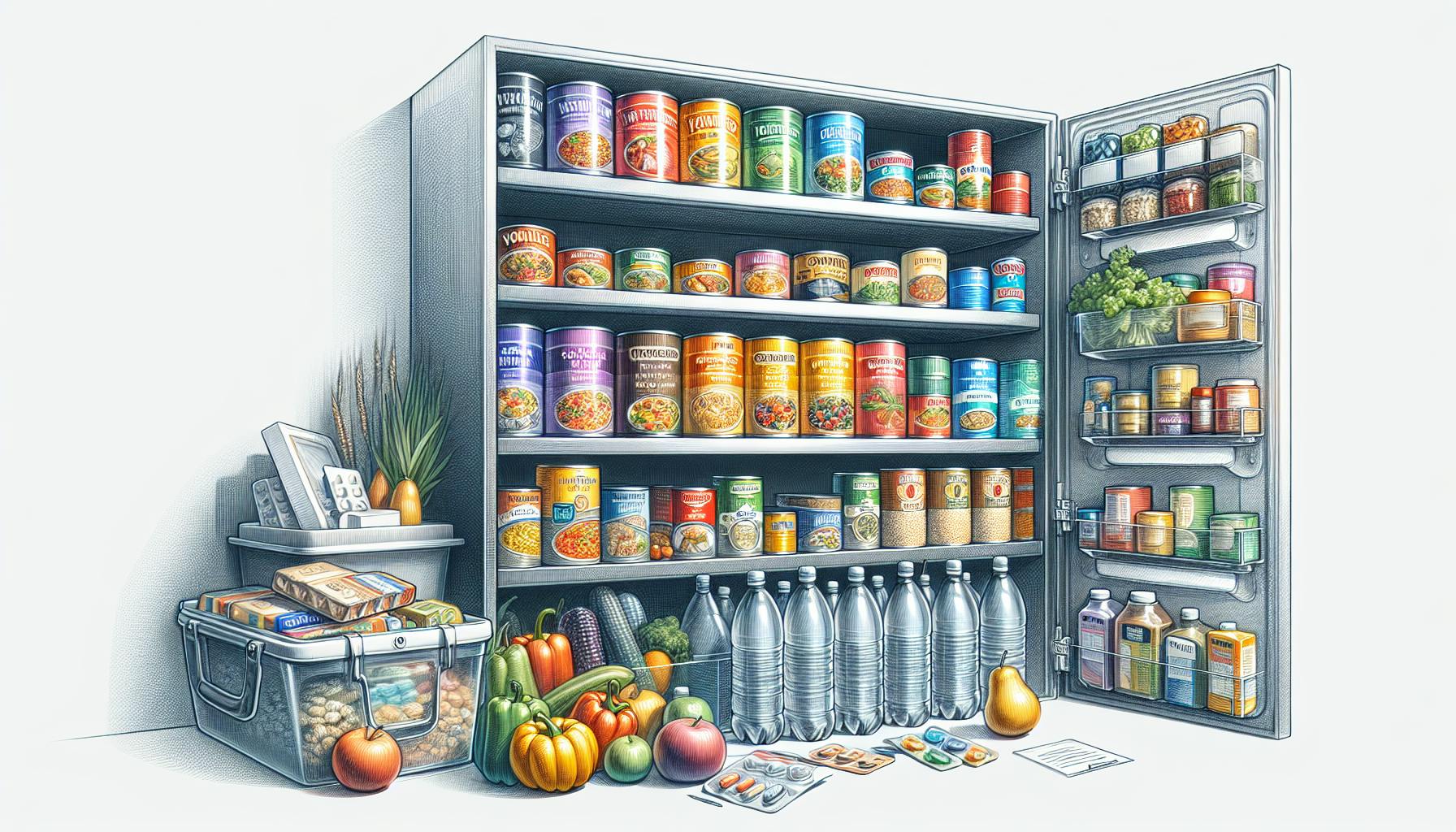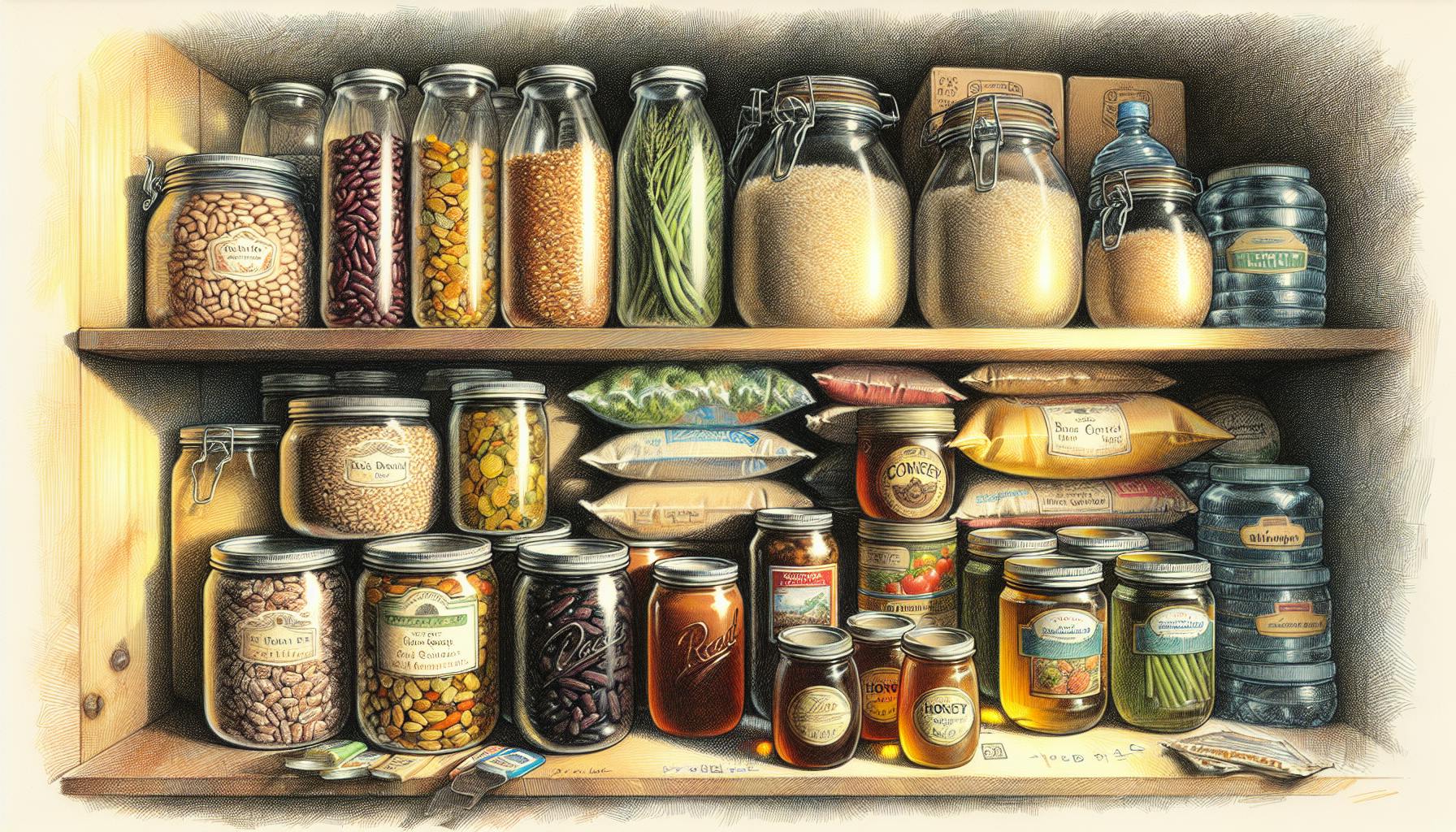When building an emergency food supply, most will agree that nutrition and shelf life are crucial considerations.
By carefully selecting nutrient-dense, non-perishable foods, you can create a well-balanced bug out bag to sustain you through unexpected emergencies.
In this article, we'll explore the essentials for stocking your bug out bag, including high-protein foods with a long shelf life, hydration sources, vitamins and minerals from fruits and vegetables, and more.
Introduction to Bug Out Food Essentials
When preparing for an emergency, having a stockpile of non-perishable food is essential. Bug out food allows you to grab necessities and go if you need to evacuate quickly. This guide covers the best options for nutrition, shelf life, storage, and ease of preparation.
Understanding the Best Food for Bug Out Bag
When choosing bug out food, prioritize:
- Nutrition: Foods like beans, nuts, canned fish, and peanut butter provide protein. Dried fruits, vegetables, and 100% fruit juice offer vitamins and minerals. Include fortified cereals and meal replacement drinks for balanced nutrition.
- Long shelf life: Opt for commercially packaged foods with expiration dates 1-5 years out. Properly stored white rice, dried pasta, oats, and wheat berries also last years. Rotate stock routinely.
- Easy preparation: Choose no-cook options when possible. Canned foods, protein bars, and dehydrated camping meals prepare quickly. If cooking, pack a lightweight backpacking stove and fuel.
Evaluating Non Perishable Food for Emergency
Well-rounded non perishable foods to include in an emergency kit:
- Canned meats like tuna, chicken, salmon
- Canned beans, vegetables, and fruits
- Peanut butter and other nut butters
- Dried fruits and vegetables
- Cereals, granola bars
- Nuts and trail mixes
- Powdered milk, plant-based milk
- Comfort foods like candy, cookies, soup
Focus on variety, nutrition, and your household's needs. Check expiration dates routinely and replace as needed.
Creating a Balanced Bug Out Food List
A balanced bug out food list covers:
- Macronutrients: Pack carbs for energy (oats, rice, quinoa), protein for fullness (tuna, nut butter, jerky), and healthy fats (nuts, seeds).
- Micronutrients: Include fruits and veggies for vitamins and minerals (canned, dried, or juice).
- Hydration: Stock powdered sports drinks, broth cubes, tea, and coffee.
- Special needs: Accommodate medical conditions, allergies, infants, etc.
Aim for 2,000 calories per person daily. Weigh and track servings removed to monitor supply.
Bug Out Food Ideas: What to Include
Some specific bug out food items to consider:
- Canned tuna, salmon, chicken
- Beef or turkey jerky
- Peanut butter powder
- Protein bars and shakes
- Oatmeal packets
- Pasta and rice
- Trail mixes with dried fruit
- Applesauce pouches
- Powdered milk and eggs
- Electrolyte drink mixes
- Vegetable and bean soups
- Freeze-dried backpacking meals
Focus on compact, nutrient-dense options you can prepare quickly.
The Importance of an Emergency Fund for Food Supply
An emergency fund ensures you can restock perishable food and purchase additional bug out supplies as needed. Experts recommend saving enough to cover 3-6 months of expenses.
Prioritize building savings so you can maintain your food stockpile despite unexpected costs. An emergency fund also enables preparedness if disaster strikes.
What foods are good for bug out bag?
"Just add water" foods like dehydrated and freeze-dried meals are ideal bug out bag items. These foods require minimal preparation, making them convenient to pack and eat on-the-go. Some good options include:
- Dehydrated fruits and vegetables - These are nutritious, lightweight, and have a long shelf life. Fruits like apples, bananas, strawberries, and pineapple make great choices. For vegetables, options like carrots, sweet potatoes, broccoli, and spinach are packed with vitamins.
- Freeze-dried meats - Beef, chicken, turkey, and tuna freeze exceptionally well. They rehydrate quickly with hot water, providing protein when you need it most.
- Instant oatmeal or grits packets - Carbohydrate-rich oats and grits are filling comfort foods that can be prepared with cold water if necessary. Go for plain or lightly flavored varieties.
- Mashed potato pouches - Packets of instant mashed potatoes are hearty, convenient, and don't require cooking. Choose ones with added vitamins and minerals for an extra nutrition boost.
- Protein/granola bars - These compact bars deliver a quick shot of energy from carbs, protein, and healthy fats. Prioritize all-natural bars without lots of added sugars.
No matter what you choose, be sure to check expiration dates and follow storage instructions. Properly stored bug out bag food can provide the nutrients and energy you need in an emergency.
What is the best non-perishable food for emergency?
When building your emergency food supply, focus on nutrient-dense non-perishable foods with a long shelf life. Some great options include:
- Canned goods like beans, vegetables, fruits, soups, chili, etc. Opt for low-sodium varieties when possible.
- Whole grains like brown rice, oats, quinoa, pasta. Store in airtight containers.
- Nut butters like peanut butter or almond butter.
- Dried fruits and vegetables.
- Nuts and trail mixes.
- Protein-rich items like canned tuna, salmon, chicken.
- Powdered milk, evaporated milk.
- Cereals, granola bars.
- Canned or jarred sauces and condiments like pasta sauce, salsa, mustard, etc.
- Comfort foods like cookies, candy, chocolate, coffee, tea bags.
When stocking up, pay attention to expiration dates and store items properly to maximize freshness. Have a variety of foods and don't forget utensils, a can opener, and a camp stove. Rotate and replace items as you use them. With some planning, you can build a nutritious emergency food supply.
What foods should I stockpile for survival?
When building your emergency food supply, focus on shelf-stable items that provide nutrition, calories, and versatility. Some essentials to stockpile include:
- Canned goods: Fruits, vegetables, beans, soups, meats, and seafood canned goods are convenient, long-lasting options. Opt for low-sodium varieties when possible.
- Grains: Whole grains like rice, quinoa, oats, and pasta have long shelf lives. Store them properly in airtight containers. Consider whole grain crackers, cereal, and granola too.
- Nut butters: High in protein and healthy fats, nut butters like peanut butter provide lasting energy.
- Dried fruits and vegetables: Dried options like raisins, apples, carrots, potatoes, and onions rehydrate well for meals.
- Oils and fats: Having vegetable oil, olive oil, shortening, or ghee on hand provides essential fatty acids and makes other foods more palatable.
- Sweeteners: Sugar, honey, maple syrup, and molasses can help satisfy a sweet tooth while providing quick energy.
- Comfort foods: Don't forget about coffee, tea, powdered milk, jelly, and crackers to help lift morale.
When stocking up on survival foods, focus on nutrient density, versatility, and personal preferences to build a well-rounded stash that covers your nutritional needs. Properly stored in a cool, dark place, many of these items can last 5-10 years when unopened.
sbb-itb-b932644
Is peanut butter good for a bug out bag?
Peanut butter is an excellent food to include in your bug out bag. Here's why:
Nutrient-dense
- Peanut butter is high in protein, healthy fats, fiber, vitamins and minerals. Just a couple tablespoons provides a substantial amount of your daily nutrition needs. This makes it perfect for emergency situations when you need nutrient-dense foods.
Long shelf life
- Unopened peanut butter can last up to 9 months past its "best by" date. An unopened jar stored properly in a cool, dark place can last even longer - up to a year. This long shelf life is ideal for bug out bag food.
Packs calories and protein
- With about 100 calories and 5 grams of protein per tablespoon, peanut butter packs a lot of energy and muscle-maintaining nutrients in a small serving size. Easy to transport and requiring no refrigeration, it's a perfect compact protein source.
Satisfies hunger
- The protein, fat, and fiber in peanut butter help you feel fuller longer compared to other compact bug out foods like granola bars. This can prevent hunger and energy crashes in an emergency situation.
So in short, peanut butter checks all the boxes for an ideal bug out food. It stores easily, provides essential nutrients, and keeps you feeling energized. Consider packing single-serve peanut butter packets or a small reusable container of peanut butter in your bag.
Selecting Nutrient-Dense Foods for Your Bug Out Bag
When choosing foods for your emergency bug out bag, it's important to select items that will provide sustained energy and key nutrients to help you survive during a crisis. Here are some tips for picking the best bug out foods:
High-Energy Foods That Don't Have to Refrigerate
Foods that are high in protein, complex carbohydrates, and healthy fats can give you lasting energy when refrigeration is not available. Some good options include:
- Canned meats like tuna, salmon, chicken, turkey, and Vienna sausages
- Canned beans, chickpeas, and lentils
- Nuts and nut butters
- Dried fruits like raisins, cranberries, and apricots
- Whole grain crackers and cereal
- Peanut butter or cheese crackers
- Beef jerky or pemmican
Rotate these non-perishable foods regularly and check expiration dates to ensure freshness.
Choosing Low-Sodium Canned Varieties
While canned goods are convenient for bug out bags, many are high in sodium. Seek out low-sodium options whenever possible. Canned veggies, fruits packed in juice (not syrup), and no-salt-added beans and meats are better choices that can still provide you with essential nutrients.
Incorporating Foods with Long Shelf Lives
Some key items to include are:
- White rice: lasts 30 years when stored properly
- Oats: lasts 1-2 years
- Pasta: lasts 1-2 years
- Honey: lasts forever unopened
- Salt: lasts forever
- Soy sauce: several years unopened
- Vegetable oil: 1 year unopened
Check expiration or best-by dates and store items properly to maximize freshness.
Protein Sources: Canned and Dried Options
Good portable sources of protein for your bug out bag include:
- Canned tuna, salmon, chicken, turkey, ham and Vienna sausages
- Canned or dried beans and lentils
- Beef or turkey jerky
- Hard cheeses like cheddar or Parmesan
- Peanut or almond butter
- Nuts and seeds
Canned meats provide protein and can be eaten cold if needed. Beans, legumes, jerky, nuts and nut butters are also handy.
The Role of Grains and Legumes
Finally, incorporate some versatile grains and legumes like:
- White rice, oats, quinoa, barley and pasta
- Dried beans like kidney, pinto and black beans
- Lentils
- Dried peas
Properly stored flour, rice, oats, beans and lentils can last 1-2 years and provide carbohydrates, protein, fiber and nutrients. They offer flexibility for many easy meals.
Choosing nutrient-dense, non-perishable foods with long shelf lives ensures you'll have sustaining energy and nutrition during an emergency situation when relying on your bug out bag. Check expiration dates routinely and store items properly.
Storing and Preparing Bug Out Foods
Maintaining safe storage conditions is critical for keeping foods fresh and preventing spoilage during an emergency. Here are some tips:
Maintaining Safe Storage Conditions
- Store items in a cool, dark place, around 40-50°F if possible. Temperature fluctuations can shorten shelf life.
- Check expiration dates routinely and use older items first following the "first in, first out" principle.
- Properly stored white flour keeps 12-18 months, while whole grains keep 6-12 months.
- Opt for canned varieties which provide essential nutrients and often have longer shelf lives of 2-5 years. Choose low-sodium options if available.
Hydration: Creating and Storing an Emergency Water Supply
- Drink at least one gallon of water per person daily to stay healthy. Dehydration causes fatigue and impairs judgment.
- Store commercially bottled water or fill cleaned 2-liter bottles with tap water. Replace every six months.
- Consider water filtration/purification methods like boiling, chlorine bleach, or a Berkey water filter to ensure potability.
Essential Cooking Gear for Emergency Food Preparation
Having basic cooking equipment enables preparing shelf-stable foods:
- Pack a lightweight backpacking stove and fuel canisters for boiling water and cooking.
- A mess kit or metal pots allow for cooking beans, rice, pasta, etc.
- Include a manual can opener, utensils, cups, and biodegradable soap.
Ensuring Food Safety During Emergencies
- Practice good hygiene - wash hands before handling food and after using restroom.
- Cook foods thoroughly. Use a food thermometer to verify safe temperatures.
- Avoid cross-contamination by separating raw and cooked foods. Discard food with an odd smell or appearance.
Special Dietary Considerations
- Stock gluten-free and dairy-free options if needed.
- Accommodate diabetic diets by storing complex carbs and high-fiber foods.
- Check labels for allergens like nuts, eggs, soy, etc. when packing bug out bags.
Building Your Bug Out Food Supply
Use this bug out food checklist to stock your bag with 3 days to 2 weeks of essentials based on your plan.
57 Foods to Stockpile for Long-Term Emergencies
When building your emergency food supply, focus on shelf-stable items that provide a balance of nutrients and calories. Some foods to consider stockpiling include:
- Canned proteins like tuna, chicken, salmon, beans, etc. Choose low-sodium options when possible.
- Whole grains like brown rice, oats, quinoa, pasta
- Dried fruits and vegetables
- Nuts and trail mixes
- Nut butters like peanut butter or almond butter
- Cereals, granola bars
- Canned soups and vegetables
- Comfort foods like chocolate, coffee, tea
Rotate through non-perishable foods before expiration dates and store properly to maximize freshness.
Ready-to-Eat Meals and Snacks
For easy bug out bag meals, pack ready-to-eat foods that require little preparation:
- Canned tuna, chicken, or salmon with crackers
- Peanut butter on whole grain bread or crackers
- Protein or granola bars
- Dried fruits and nut trail mixes
- Applesauce pouches
- Canned pasta meals or soups
Resealable pouches and single-serve packages allow for grab-and-go eating.
Dairy Alternatives and Nut Butters
Since dairy products won't keep long unrefrigerated, include shelf-stable alternatives for protein and fat:
- Nut butters like peanut, almond, cashew
- Powdered milk or milk alternatives
- Canned coconut milk
Nut butters provide protein and healthy fats and can be eaten alone or spread on crackers or bread.
Essential Vitamins and Minerals from Fruits and Vegetables
Pack canned, pouched or dried produce to ensure a supply of vitamins and minerals:
- Canned tomatoes, vegetables, beans
- Dried fruits like raisins, cranberries, apricots
- Applesauce pouches
- 100% fruit leather
Seek low-sodium and no sugar added options when possible.
Packaging and Portability of Food Items
When selecting bug out foods, consider:
- Resealable pouches over cans to save weight
- Individual packets for grab-and-go eating
- Items not needing refrigeration or preparation
- Balance of nutrition, calories, variety and shelf life
Prioritize portable, nutrient-dense foods suited for your specific situation. Update food items every 6-12 months to ensure freshness. With the proper selection and storage of foods, you can build an emergency food supply to rely on when needed most.
Key Takeaways for Emergency Preparedness
Being prepared for emergencies requires having a well-stocked bug out bag with non-perishable foods and an effective emergency plan. Here are some key takeaways:
Comprehensive Nutrition in Emergency Situations
When selecting foods for your bug out bag, it's important to choose options that provide a balance of protein, carbohydrates, healthy fats, vitamins and minerals. This will help support health and prevent nutritional deficiencies during an emergency. Some good options include canned beans, tuna or salmon, nut butters, dried fruits and nuts.
Regularly Updating Your Emergency Preparedness Kit
Don't just assemble your bug out bag and forget about it. You should routinely check expiration dates and storage conditions to ensure foods remain fresh and safe to eat. Replace expired items and inspect containers for signs of spoilage. Setting reminders to update your kit every 6-12 months is recommended.
Customizing Your Bug Out Food Selection
Consider any dietary restrictions, allergies or personal preferences when choosing foods for your kit. For example, include gluten-free and vegetarian options if needed. The key is tailoring your food supply to meet your specific needs.
Practical Experience with Emergency Food and Gear
To make sure you know how to properly prepare and consume your emergency food, try incorporating some of it into camping trips or emergency preparedness drills. Hands-on practice using your portable stove, water filter and other gear will help boost confidence in your abilities.
Being prepared with nutritious food and an effective plan will help you safely weather emergencies. Use these tips to customize your bug out bag and keep it updated for readiness at any time.


